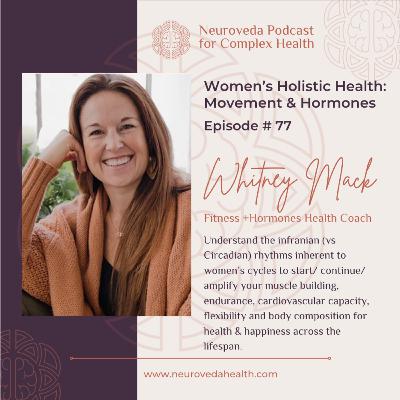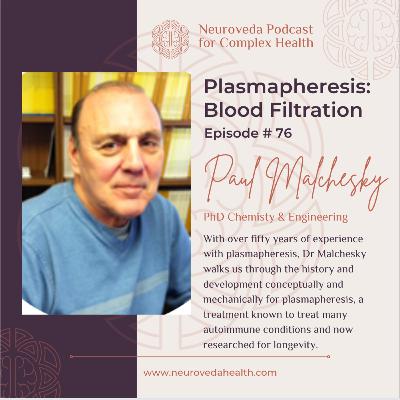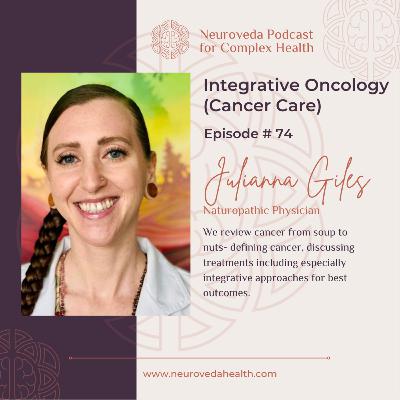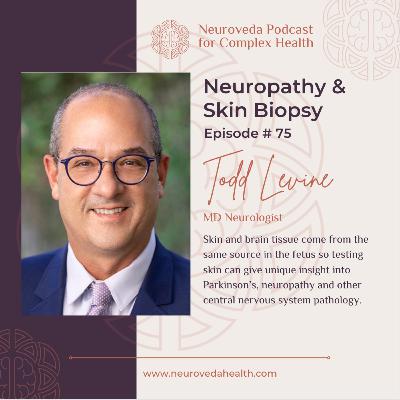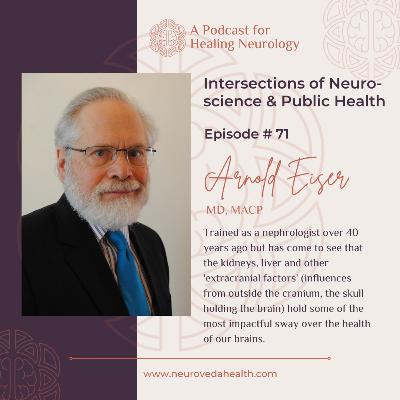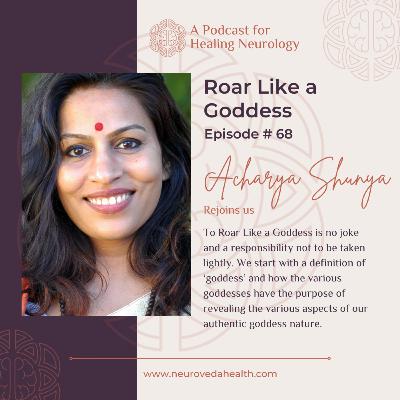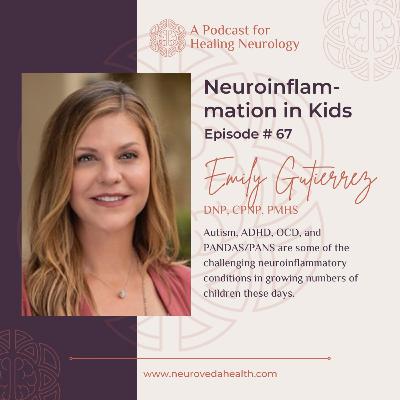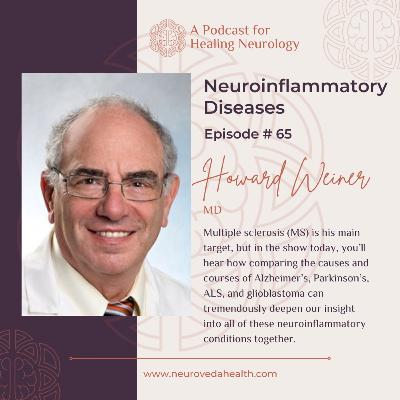Discover Neuroveda Podcast for Complex Health
Neuroveda Podcast for Complex Health

Neuroveda Podcast for Complex Health
Author: Gillian Ehrlich
Subscribed: 29Played: 377Subscribe
Share
© Gillian Ehrlich
Description
Certified in Ayurveda and Functional Medicine, Nurse Practitioner Gillian Ehrlich, DNP, ARNP, IFMCP interviews guests who dive deeply into the nuances of medicine with the goal of inspiring you to persistently heal in the face of inevitable challenge across the lifespan. This is about ancient & cutting-edge understanding of disease processes and treatments just as much as it is about food, lifestyle, nature, culture, and politics.
85 Episodes
Reverse
Description.
This is a power-packed episode in which Whitney Mack walks us through what women should have been taught since birth about how our bodies work and how we can care for them lifelong. Turns out, we have an infradian (vs circadian) rhythm that drives our cellular communication/ hormones systems over time. This means that we are in constant cycles of change, just like the moon that cycles through from new to full and back to new. To anchor into our holistic health, we can emphasis sleep, nutrition and movement in alignment with these cycles.
Whitney's training & deep personal understanding of these concepts brings them to clarity throughout this show. We start with a complete definition of 'fitness' including muscle strength, endurance, cardiovascular capacity, flexibility & body composition. Then we interweave the hormones, recognizing the 'Queen' hormones of cortisol & insulin as they serve for survival (vs estrogen, progesterone & testosterone which are for life quality). Next we dive into the four hormonal stages across the lifespan: menarche, cycling, perimenopause and post-menopause. With each, we review ways to attend to our movement patterns. And then we bring it back to the daily life.
This is an episode not to be missed & to be shared with every girl and woman we know!
BIO:
As a holistic health, hormones + movement coach, Whitney Mack helps busy, driven women thrive in their bodies, reawaken their aliveness, and create a more purposeful way of being. Through her hormone-informed approach, she blends the science of female physiology with the sacredness of the body to help women achieve optimal health and well-being throughout all hormone + life seasons. If you're ready to heal your relationship with your body and unleash your feminine power, her signature method uses hormones as a compass to guide you back to your inner-knowing and cultivate deeper self-awareness for sustainable transformation in less time and with lots of
love. Find Whitney through her website: WhitneyMack.com
Dr Paul Malchesky, with a Master’s degree in Chemistry and a Doctorate in Engineering, has been working with apheresis since the 1970’s. This is a blood filtration or ‘cleaning’ therapy we offer at Neuroveda Health as plasmapheresis (also called plasma exchange, PLEX and TPE (total or therapeutic plasma exchange)). There’s been a lot of recent excitement regarding treatment of Long-COVID and as a ‘biohack’ for longevity, but the truth is that it’s been nearly half a century since the FDA approved this therapy for auto-immune and neurodegenerative conditions. The technology has come a long way and Dr Malchesky has been there the whole time. Of note, Ayurveda, the traditional medical system of India, also recognizes the value of detox and blood cleansing, making plasmapheresis a type of ‘rakta moksha’. This is a modern tool with ancient roots, our favorite kind of therapy. Today, we get into the history and mechanics to describe what this therapy is doing and how broad it’s use can be.
We discuss:
· 3:30 What is apheresis?
· 4:19 What is the history of apheresis?
· 11:56 What is in blood? What are the
components of blood?
· 13.20 About anti-coagulation
· 15:53 Ayurvedic use of blood cleansing
called ‘rakta moksa’
· 18:06 Dr Malchesky’s personal history with
apheresis starting with 1972; Reporting up to 40 diseases treated by 1981.
· 24:40 Comparison of dialysis vs plasmapheresis filtration
· 29:00 Late 70’s/ early 80’s, efforts
to identify the specific proteins associated with certain diseases; findings and curiosity about cryoproteins- precipitates triggered by cold.
· 36:57 Treatment to remove high cholesterol
to prevent atherosclerosis.
· 40:29 Description of the last 15 years
of apheresis: applications & guidelines have really diversified by geography (centripetal in US & German; membrane for Japan), technology and disease state
· 42:58 Safety of this procedure
· 43:52 Difficulties with this procedure are most typically associated with venous access and sometimes blood pressure changes and/or anti-coagulant use
· 44:40 Recognition that the macromolecules
produced as ‘toxic’ can present in every silo of medicine: oncology, rheumatology, neurology, and therefore, also make sense to use these treatments for longevity & anti-aging
· 49:43 In studying the toxins removed, it’s evident that these toxins removed impair cellular function, so removal can allow cells to perform more of their regular functions.
· 51:08 The goal at Neuroveda Health is
that plasmapheresis is part of a larger medical and wellness program to renovate the health from the ground up.
· 51:38 Discussion of Lp(a).
· 53:24 Designing clinical trials using
historical experience of the questions and initial clinical trial endeavors with rheumatoid arthritis patients
BIO: Dr. Paul Malchesky holds a B.S. Degree in Chemistry
from St. Francis University, M.S. degrees in Chemistry from Case Western Reserve University and in Chemical Engineering from Cleveland State University and a Doctorate in Engineering from Cleveland State University. He is President of the International Center for Artificial Organs and Transplantation (ICAOT) and consults for the chemical and medical industries.
He has published extensively nearly 500 publications, holds 35 patents, and was co-editor of four books on apheresis. He is active in various professional societies and is the former Editor-in-Chief of Artificial Organs and Managing Editor of Therapeutic Apheresis and Dialysis. He is a Past-President of the International Society for Apheresis. He is an Elected Fellow to the American Institute for Medical and Biological Engineering and The Ohio Academy of Science.
Recently he developed the web site icaot.org that discusses the history of the International Center for Artificial Organs & Transplantation and includes Milestones in the field and invites contributions to its Virtual Collection.
Cancer is a tremendous topic. Dr Julianna Giles, ND, has
focused her career on evidence-based approaches for this complex condition. Dr Giles now directs our Integrative Oncology program at Neuroveda Health in Seattle, Washington. In this podcast, she walks us through cancer, soup to nuts. This includes defining cancer, describing different types and stages of cancer, and the conventional treatments of surgery, radiation chemotherapy and now immunotherapy. Dr Giles then layers in integrative approaches including high-dose (aka ‘pro-oxidant’) IV vitamin C, other botanicals, metabolic approaches to treating cancer and the relationship between other immune dysfunction, like auto-immune disease or chronic viral infections, to cancer development. Next is a review of the core elements of our program, including specialty liquid biopsy testing, the timing necessary for balancing pro-oxidation (chemo) with anti-oxidant (recovery) targets, and the value we place on collaboration with conventional oncologists and treatments. We welcome patients to our program at all stages of cancer status including those with a family history seeking prevention, monitoring for early detection (we do pap/ HPV testing in clinic), treatment at all stages (early, middle, late), post-chemo/radiation recovery, prevention of recurrence and palliative care/ hospice as it’s needed. Listen in and please share widely with those who are being affected by cancer. This is a critical show for broadening ideas about treatment options and maintaining agency at a time when health stress can
be overwhelming.
We discuss:
· 3:20 What is cancer?
· 6:36: How do we think and name different types of cancer?
· 9:09 Ayurvedic perspective of cancer
· 11:25 How does conventional care typically treat
cancer? Surgery, radiation, chemotherapy
· 17:12 High dose IV (intravenous) vitamin C to
make chemotherapy more tolerant to the body and prevent recurrences.
· 25:00 Fasting and chemotherapy treatment
· 28:35 Discussion about immunotherapy and metronomic (aka low dose) chemotherapy
· 32:12 Defining Integrative Oncology including the value of collaboration to help conventional treatments to work better
· 33:34 Looking at the foundations of health: asking and answering the ‘why’ and ‘why now’ questions
· 35:33 Molecular targets of botanicals, for
example, p53 targeted by no drugs but impacted by curcumin;
· 36:55: Use of botanicals, diet and lifestyle as
anti-inflammatory influences during pro-oxidant treatments like chemo- it’s all about timing!
· 42:33 Discussion of the Integrative Oncology
program at Neuroveda Health
· 56:30 Liquid biopsies looking for cell free mutated
DNA shedding from cancers in the body
· 1:03:33: Putting together integrative treatment
plans including the metabolic approach to cancer treatment ( Care Oncology protocol out of the UK)
· 1:08: How cancer interacts with the rest of the
immune system, including auto-immune disease
· 1:12:38 Recovery after cancer treatment
Bio: Julianna Giles is a Naturopathic Physician with a
Masters in Ayurveda who specializes in integrative oncology, endocrinology, chronic infections, medical cannabis, entheogens and psychoneuroimmunology. After graduation from Bastyr University, she completed four years of residency training in integrative oncology. She is a core lecturer for the Academy of Cannabis Science and lead formulator for Polite and Lumna, both medical cannabis companies. While at the University of Wisconsin, Madison, she researched medicinal mushrooms and medical cannabis as adjunctive cancer therapies, as well as the neurological effects of mindfulness at the Wisconsin Institute for Sleep & Consciousness. Dr Giles is certified in Ayurveda Yoga therapy, Prana Flow and Kundalini Yoga. In her free time, she practices Yoga, is passionate about plant-based cooking, and loves exploring the wild Pacific Northwest.
Description:
Dr Todd Levine, with 20 years of experience as a clinical neurologist with specialty in disorders of the peripheral nervous system, shares with us about the Syn-One skin biopsy run by his company, CND Life Sciences.
Against a backdrop of clinical information about the divisions of the nervous system (central vs peripheral and sensory vs motor vs autonomic), we review the 3 tests in this procedure: small fiber nerve counts, synuclein and amyloid deposition.
Dr Levine notes that brain & skin both come from ectoderm tissue in the embryo, meaning they arise from similar roots soon after conception The skin, unlike the brain, is readily available for testing, and can offer insight to what’s potentially happening in the central nervous system without having to go there directly.
It’s also a fascinating conversation that one-half to one-third of all neuropathies end up classified as ‘idiopathic’,
meaning we can’t identify a trigger, like toxic chemical insult or injury. Most likely, these neurons are injured by ‘an accumulation of small insults” which can include low but recurrent or persistent viral illnesses and environmental chemical exposure all further complicated with and by metabolic syndromes. His most exciting area of research is looking at the potential of this test to give
predictive insights for diseases decades in the making (like Parkinson’s or Lewy Body Dementia), all work that we agree with & support at Neuroveda Health when we apply personalized medicine plans for your best health.
BIO:
Dr. Todd Levine has over 20 years of experience as a
clinical neurologist with a sub-specialty in disorders of the peripheral nervous system. He received his medical degree from Duke University and did his residency and fellowship at Washington University in St Louis. He has served as Chairman of the Neuromuscular Division of the American Academy of Neurology. In 2010, he founded his first medical diagnostics company called Corinthian
Reference Lab (CRL), and has processed over 50,000 skin biopsies, receiving specimens from over 4,000 different neurologists across the US and Canada. Dr Levine is one of the three founders of CND Life Sciences and serves as its Chief Medical Officer, playing a key role in the delivery of diagnostic services and ongoing technology development. Dr. Levine also serves currently as the Director of Neuroscience Research at the Honor Health Research Institute in Phoenix, AZ.
Dr John Moos, MD discusses his transition from trauma surgeon to psychedelic healer- the unifying factor being proximity to trauma. He notes the trauma he initially treated with surgery most typically occurs within a container of many other traumas- social, political and economic violence, resource scarcity, fear, addiction, intergenerational traumas, ACES (Adverse Childhood Experiences) and others. His (to-be) wife looked at him one day and said “I wonder if it’s possible to heal it before it happens”, meaning, is there a way to pre-emptively address the container of trauma before the physical trauma results as the outward explosion of inner distress. Dr Moos was hooked. He completed personal experiences with plant medicine and trainings with the Psychedelic Research and Training Institute (PRATI), California Institute of Integral Studies (CIIS), and the Multidisciplinary Association for Psychedelic Studies (MAPS) for their MDMA (3,4-Methyl
enedioxy
methamphetamine) protocol and now runs MoosMD.com to offer service to people with psychedelic medicine.
In this episode, we start with a discussion about trauma. Trauma can even be created in as simple moment as a mis-attunement with a parent as a child in a critical moment and we all experience various levels of trauma throughout the lifespan. Psychedelics can be a tool (not a panacea) to understand the impact of our history on our current, daily moment. It’s the alignment and integration of your three lenses of understanding: cognition (head), somatic (heart) and embodiment (intuition).
Dr Moos recognizes that psychedelics give us a chance to step to the side of our default mode network which can also be described as a type of our identity of our consciousness. Our conversation ranges to the benefits of relationship to help us access our consciousness (this is the definition of Tantra) and these relationships can be our mind to ourselves, us to our container, or us to each other.
Then, we dive into the current research and legal perspectives about the various psychedelics- ketamine, MDMA, psilocybin, LSD and other plant medicines for treatment resistant depression, anxiety, stress, PTSD and others. He reviews the importance of set and setting which recognizes that intentional and introspective work versus the external recreation of these medicines when they are used in a non-monitored ‘party’ state. As therapy, this is to dissolve ego boundaries to better understand yourself.
We also review the chemical nature and physiological impact of these medicines including the specific activities in the brain and the impacts on our neurobiology.
Is anybody damaged beyond repair? Is any person too traumatized to heal? On being asked this question, Dr Moos offers a compassionate and insightful response about the power of our neuroplasticity as well as the tremendously oppressive conditions of social, political and economic injustice and the persistent squeeze of growing pollution and climate change.
We close this show with a description about the Ketamine Assisted Therapy (KAP) process and what to look for in finding a safe and insightful session.
What I love about this show is that while we talk about ketamine and other psychedelics as a medicinal tool, this show is really about the nature of healing and reality.
Find out more about Dr Moos & his practice at https://moosmd.com/
Dr Jennifer Bahr is a Naturopathic Physician with deep interest, experience and success in treating children using Classical Homeopathy for PANS (Pediatric Acute-Onset Neuropsychiatric Syndrome) and PANDAS (Pediatric Acute-Onset Neuropsychiatric Disease Associated with Streptococcus).
We start this show with the fascinating story of Homeopathy- history, mechanisms and current practice around the world. The American Institute of Homeopathy (AIH) was actually the first medical society formed in the United States in 1844. The Homeopathic Pharmacopeia of the United States, still regulated by the FDA, recognizes over 1000 remedies. Research first published in 2010 used scanning microscopy to identify nanoparticles of a homeopathic remedy’s plant, animal and mineral sources in what is so ultra-diluted that it was previously considered nearly nothing (smaller than Avogadro’s number!). With this same technology, it can be measured that there are physiological changes like tiny like nudges that can impart significant trajectory changes in a child’s health.
Then we dive into PANS/PANDAS. Although there is more research about PANDAS (meaning symptoms associated with strep infection), triggers can be well beyond Strep, which is the nature of the condition known as PANS. Children can present with debilitating fear, rage, sleep disruptions, intense separation anxiety, reading/ math regression, toilet training regressions, distinct behavioral changes, tics, avoidant-restrictive food disorder, and OCD (obsessive-compulsive disorder). It’s thought to happen in relation to an infective insult, but this may be so subtle as to not even be recognized (even mold in a home). PANS and PANDAS can be thought of as an immune system susceptibility; Homeopathy addresses susceptibilities to repair the biochemical patterns in realms that conventional medicine does not yet operate.
This is an incredible show that gives an excellent introduction to Homeopathy as well treatment possibilities for children and families truly suffering with these severe, often inconsolable, symptoms. We recorded this show with Dr Bahr precisely because of the results we are seeing in clinic with patients who have engaged with the Resilience Naturopathic team (demand is so great she has 16 clinicians on her team that see patients remotely around the world). Throughout the show, she weaves through her personal story, which is so insightful for both process and progress, but also demonstrates how life can feel in an effective treatment vacuum.
Please listen in and share widely.
Find out more about her, Resilience Naturopathic and PANS/PANDAS at the resources below.
Resilience Naturopathic
p: 858-461-8121
a: 3633 Camino Del Rio South, Suite 103 San Diego, CA, 92108
w: www.resiliencenaturopathic.com
e: jessica@resiliencenaturopathic.com
Join our FREE FB Group for our free mini course on PANS/ PANDAS solutions and lots of great conversation and support!
YouTube Channel for Resilience Naturopathic.
Dr Arnold Eiser, MD, MACP trained as a nephrologist over 40 years ago but has come to see that the kidneys, liver and other 'extracranial factors' (influences from outside the cranium, the skull holding the brain) hold some of the most impactful sway over the health of our brains. He's termed this relationship between organ dysfunction in the body to assumed compromise in central nervous system brain neuroinflammation Eiser's Corollary of Related Toxicity. His book, Preserving Brain Health in a Toxic Age: New insights from neuroscience, integrative medicine and public health (Rowman & Littlefield, Oct 2021) explores this topic in depth. He examines the ways in which environmental policy, corporate pollutive behavior, metals, microbes, common medications like acetaminophen (Tylenol), and experiences with digital violence seem to hasten neuroinflammatory changes that can present as our current epidemics of autism and Alzheimer's Disease. It's a multi-tiered attack on the nervous system that our society doesn't loop back to true root causes. The book explores the interface between the chemical environment and industrial and agricultural practices.. He notes almost all neurotoxins are also carcinogenics and recognizes the key role of the liver as a front-line organ for protection or vulnerability for brain inflammation- and then notes the epidemic of non-alcoholic fatty acid disease in the modern world. He notes that CFS/ dysautonomia was originally described in the 1800's as a 'disease of modernity' associated with newspaper printing and rail travel. We then talk about the integrative medicine, high fructose corn syrup, nutrients, spices, and in the process really listing out many of the ways we can make our whole world medicine better at preserving brain health.
Find the book: https://www.amazon.com/Preserving-Brain-Health-Toxic-Age/dp/1538158078
or https://rowman.com/ISBN/9781538158074/Preserving-Brain-Health-in-a-Toxic-Age-New-Insights-from-Neuroscience-Integrative-Medicine-and-Public-Health
Microglial cells are responsible for sensing and driving the immune response in the central nervous system. Their activity, be it supportive or destructive, can be at the root of many different neuroinflammatory conditions including diseases like MS, ALS, Alzheimer’s, Parkinson’s, and TBI (Traumatic Brain Injury), but may also play a large role in the vague hallmark symptoms of complex and chronic disease like brain fog, fatigue, pain, alertness and mood changes including OCD, ADD, and depression.
Dr Singhal systematically walks us through an easily understood description of the types of cells in the brain (neurons, macroglia (astrocytes & oligodendrocytes), microglia) and their functions. The microglia are a fascinating type of neuroimmune cell that sense and act protectively in good times and then can change shape and release various cytokines, chemokine and neurotransmitters in response to the development of disease, which then impacts microglia function further. We used to only be able to see this on autopsy- there are no blood tests available to measure microglial activation (although neurofilament light chains (NfL) from neurons and glial fibrillary acid protein (GFAP) from astrocytes can reflect central nervous system cellular injury).
But PET imaging can visualize microglial activation! Dr Singhal explains in elucidating detail the nature, function, and power of Positron Emission Tomography (PET) imaging, like starting with the Big Bang, anti-matter particles, medical cyclotrons and gamma rays. “PET brings physics, chemistry and biology together in real time to provide novel insights at a cellular and molecular level”, including microglial activation. “If you know yourself and know your enemy, you’ll win 1000 battles” is the way he describes what PET can do for neuroinflammatory conditions.
We end the show with a discussion of treatment theories and options targeting microglial activation. It’s a combination of re-evaluating known therapies (even the old antibiotic minocycline!) for their impact on microglia as well as mention of some novel therapies, including a nasal spray ‘vaccine’ for MS. Of course, we bring up non-pharmacologic therapy potentials including exercise, the Ayurvedic perspective including panchakarma detoxification, the power of breathing to impact cerebrospinal fluid flow, ketogenic diet, and consideration of various adaptogenic herbs with the goal of supporting the immune system’s intelligence.
Recorded on Friday, June 24, 2022, the day Roe v Wade was overturned by the United States Supreme Court, when safe full-scale reproductive health care responsibility was returned back to the states resulting in millions of women losing access to accurate information about safe reproductive care, this episode lays out the realities of abortion.
We know this decision will inflict a range of dangers, even well beyond the simple forcing of women to continue undesired pregnancies with all of the physical, emotional and financial realities (the Turn Away Study shows mental health may recover but physical and financial outcomes are worse for women who wanted but had no access to abortion care).
We know there is already an increasing frequency of delayed or denied miscarriage management, refusal to treat life-threatening pregnancy conditions like ectopic pregnancy, and fetal abnormalities not compatible with life that are forced to persist until their extensively painful and grueling end for both mom and fetus.
Dr Anuj Khattar is a Family Practice MD who has traveled the country providing reproductive care to women. After witnessing child abuse in the emergency room during his training, he chose this specialty to prevent that by supporting women to be in charge of their bodies, including their reproductive choices. He found he loves doing this work because of the deep listening it requires. Dr Khattar has learned from his patients that abortion is never a decision taken lightly. Behind every decision is a carefully weighed thought process to go this route. He notes 90% of abortions occur in the first trimester (12-14 weeks) when the abortion pill (mifepristone and misoprostol) is safe and effective, and that the majority of abortions are women who are already mothers; these are women who are making an informed decision.
In this episode, we discuss:
The reason for an abortion is irrelevant; our judgment is irrelevant. Abortion care is health care.
With the advent of medical abortion pills, which are available through the mail and are FDA approved through 11 weeks (with evidence & global experience showing likely safety up to 20 weeks), the post-Roe world is different than the pre-Roe world; see the documentary “The Janes” to understand more about that.
The physical realities of abortion are demanding on a woman’s body; beyond weight gain, fatigue, nausea/vomiting and connective tissue softening, there is a 20-30% chance of a Cesarean section (C-Section) delivering which is major abdominal surgery incurring any surgical risk and requiring recovery time that is not protected by any Federal paid parental leave program.
Dr Khattar also discusses the medically unsound text he has been required to read to women in certain states during abortion counseling and busts many of the other myths out there.
A conversation on contraception, which is NOT abortion, even Plan B which is available over the counter without a doctor’s prescription.
If the desire is truly to reduce or prevent abortions, our focus should be accurate, widely disseminated sex education, more social and financial opportunities for women, physical autonomy for women and access to contraception.
It’s a big show. It’s a big deal. Let's stand up for ourselves & each other.
Resources:
Funding Abortions: https://abortionfunds.org/
Shout Your Abortion: https://shoutyourabortion.com/resources/
Abortion finder: https://www.abortionfinder.org/
Repro Legal Hotline: https://www.reprolegalhelpline.org/
Plan C Safe Home Abortion: https://www.plancpills.org/
To Roar Like a Goddess is no joke and a responsibility not to be taken lightly.
In this episode, Acharya Shunya rejoins us (see Podcast for Healing Neurology episode #42: Finding the Sovereign Self) for our first show together) to review some of the juicy bits of her new book, Roar Like a Goddess.
We start with a definition of ‘goddess’ and how the various goddesses have the purpose of revealing the various aspects of our authentic goddess nature. “Just as the moonlight is no different than the moon, the self is no different from the Goddess. We are one.”
Telling the goddess stories about the power of Durga, the prosperity & ethics of Lakshmi, and the knowledge and peacefulness of Sarasvati remind us of our own inherent, indivisible raw power, intelligent discernment, and capacity for pleasure.
This was written in the ten thousand plus year old Vedas- the songs of recognizing divinity everywhere- as well as the Upanishads, which instruct us on finding divinity within our own consciousness.
And this is the first five minutes of the show. Seriously. This is a show to listen to over and over again.
These are the teachings we need to find our footing in an unstable world, to wake up our sleeping inner goddess, and to make order in our lives by rooting deeper beyond self, gender, politics, individual or community.
Honoring your goodness can be just as important as asserting boundaries, roaring with rage, questioning your generosity and even engaging in violence, with discernment, to not tolerate atrocities against vulnerable people, animals or planet.
Acharya Shunya reviews concepts of dharma (right living and connecting to our humanity), artha (prosperity, wealth), kama (pleasure, including the right pleasure of sex) and moksha (liberation). These concepts are told through mythology, story with clarity, wisdom and humor.
Tune in to remember the brilliance of your nature and find encouragement to hold the boundary only as thick as a blade of grass.
Be like the Goddess- both sweet & salty.
Resources:
· https://www.acharyashunya.com/
· https://www.awakenedself.com/
Autism, ADHD, OCD, and PANDAS/PANS are some of the challenging neuroinflammatory conditions in growing numbers of children these days. While the conventional treatment has typically been pharmaceuticals and behavioral therapies, we are truly in the midst of a paradigm shift aiming at root causes and asking 'why' and 'how' for both cause and treatment. Innovations in medicine are bringing us new evaluation tools, nuanced diagnosis capabilities, and treatment options.
Dr Emily Gutierrez, a seasoned pediatric psychiatric doctorally-prepared nurse practitioner in Austin, Texas, prioritizes these kids who need new approaches. We begin the show by walking through the names, diagnostic criteria, and developmental progressions of some of these disorders like PANDAS (Pediatric Autoimmune Neuropsychiatric Disorders Associated with Streptococcal Infections), PANS (Pediatric Acute-Onset Neuropsychiatric Syndrome), and autism spectrum disorder, including their associated symptoms of anxiety, depression, and OCD (obsessive compulsive disorder). She delineates autism as kids with global delay who have never met milestones (consider genetic testing with chromosomal microarray and Fragile X testing) versus those with regression or later development of symptoms (consider environmental triggers).
We review Dr Richard Frye's formula for regressive autism or PANS/PANDAS etiologies being 20% genetics + 80% environmental triggers, including oxidative stress (aka total toxic burden of metals, infections, mycotoxins, poor elimination), methylation deficiencies, and mitochondrial dysfunction. She notes, "Psychiatric symptoms can have an immunological basis that needs to be ruled out before sticking a kid on a medication. Maybe the med is amoxicillin instead of prozac." We get far into the details with these physiological processes.
This is an exciting conversation about understanding root causes, choosing treatment approaches and celebrating the inherent resilience of children. The earlier the intervention, the better the outcome. She emphasizes that these conditions are not the fault of the child or the parents and that it is somewhat a war of attrition, meaning, staying with it is the best way to support kids long term to become their best selves. For the benefit of our kids and society as a whole, we all need to heed the call to approach children with neuroinflammatory conditions with fresh, science-based, evidence-backed eyes- listen in to learn what this means and how it can be done.
Resources:
Dr Emily Gutierrez's clinic: https://www.neuronutritionassociates.com/
Dr Emily Gutierrez's nutritional supplement line: NeuroNutrients (coming July 2022!)
Dr Emily Gutierrez's book link: The Parent's Roadmap to Autism (2018)
MAPS: Medical Academy of Pediatric Special Needs for clinicians
TACA for parent support: The Autism Community in Action
Karyn Schwartz is a community herbalist what starts out with exactly what we need to know about herbalism, "If you are interacting with plants in any way, you are doing herbalism. If you are cooking with plants in your kitchen, you are doing herbalism. If you are making tea, you are doing herbalism. If you are sitting and listening to the grass, you are doing herbalism. There are so many ways to have relationships to plants and we are bound to them- we are always in relationship to plants. There's no oxygen without plants. We're not here unless we are in relationship to plants. Even before we talk about the consumption or utilization of plants, we have to recognize we are wholly dependent on the plant world for our existence." From there, we have a wide-ranging conversation about the ways in which relationships with plants can inform our experience in life. Karyn shares how she met different plants, like the high joy being around buckets of basil and the experimenting with making ink from choke-cherry juice. Although she didn't grow up encouraged to be close to plants, her persistence, curiosity and humility helped her learn bit by bit what this relationship is and how knowing plants makes us more human.
Find more about the Sugarpill Apothecary here.
And on Instagram here.
Dr Howard Weiner has been evaluating neuroinflammatory diseases for over forty years now. Multiple sclerosis (MS) is his main target, but in the show today, you’ll hear how comparing the causes and courses of Alzheimer’s, Parkinson’s, ALS (Amyotrophic lateral sclerosis), and glioblastoma can tremendously deepen our insight into all of these neuroinflammatory conditions together. Dr Weiner is a story-teller (and film maker! ‘What is Life? The Movie”) who starts with a description of the four types of cells that make the brain into the brain: neurons, oligodendrocytes, astrocytes, and microglia. Then it’s on to the details: MS is white blood cells entering the brain triggering inflammation, while abnormal protein accumulation is the hallmark for Alzheimer’s (amyloid & Tau proteins), Parkinson’s (alpha-synuclein in the dopaminergic areas), and ALS (TP protein and others). As we wind our way through the immune system, Dr Weiner shares their surprise at finding MS has a pathologic B-cell component. Antibody-oriented diseases can be addressed with what’s called monoclonal antibody drugs, many of which are used for MS therapy (and 1000’s of other ‘mab’ drugs for other autoimmune diseases). We then turn to the concept of using vaccines for autoimmune conditions. By priming the immune system, we can change the way it reacts to threat & inflammation- these are being considered for both Alzheimer’s (Protollin from bacteria) & MS (stimulates T cells to dampen microglial activity). This is followed with discussion about the links between the brain & the gut/ microbiome and the gut/brain axis impact on neurological disease. He notes even certain cancer therapies that work better or worse dependent on the microbiome. He lays out the challenges of large-scale trials which often don’t yield game-changing success stories but can still be of great value on the secondary analysis to tease apart the patients that did gain benefit to then work backwards judging if other similar sub-set patients could be served by said intervention. This serves for some of the upcoming potential treatments in current trials including aspects of xenon gas, 40Hz flickering light for Alzheimer’s (https://www.alz.life/), ibudilast, inhaled cromolyn to control microglial inflammation, and/or stem cell injections into the spinal cord. Dr Weiner ends by recognizing the frustration and fear that these neuroinflammatory conditions can inspire, but emphasizes the importance of having hope and the incredible gains we’ve made, which will continue, especially in treating MS, over the past 40+ years.
Resources:
· Dr Weiner’s Lab website: https://weinerlab.bwh.harvard.edu/?page_id=154
· Book: “The Brain Under Siege, solving the mystery of brain disease, and how scientists are following the clues to a cure” by Dr Howard Weiner, MD (2021)
· Book: Curing MS: How Science is Solving the Mystery of Multiple sclerosis (2005)
· Movie: What is Life- the Move: https://www.youtube.com/watch?v=MxUFD1UsCpc
Dr Aly Cohen. MD and environmental health specialist (and very entertaining speaker), gives us the full low-down about our drinking water in the U.S.. She starts out describing how the 160,000 treatment plants in the US make up ~80% of our water sources and are bound only to the regulations, restrictions and testing from the Safe Water Drinking Act of 1974. At that time, and since, it's only federally required to test for 91 known toxic chemicals; 95,000 chemicals have been introduced into our environment since the 1950's, leaving 94,909 untested for in our drinking water, at least 1000 known to be endocrine disruptors (most others are not tested so, for the most part, we don't even know their impact). She reviews some of these in detail (including a review of why endocrine disruptors are called 'disruptors'. What is in our water is cumulative of everything that goes down our drain- pharmaceuticals, metals in pipes, dead animals and literally anything that gets flushed down your toilet or washes into sewers including industrial chemicals and farm run-off. When that is 'purified', it's often done with other chemicals- chlorine or flourine, etc, that often isn't removed after it does its cleansing action. She also notes the variability of the wastewater quality can intimately depend on the day, including any climate events like floods, that also flood the wastewater plants. This is one way that climate change can directly, day by day, impact our water quality. So what to do?!? First of all, avoid chemicals in all ways possible (check out Dr Cohen's website (https://thesmarthuman.com/), TEDx talk "How to Protect Your Kids from Toxic Chemicals" (https://www.youtube.com/watch?v=HSCeP0hyuTI), Smart Human Podcast (https://thesmarthuman.com/podcast/) and her Instagram, Twitter & FaceBook page (https://www.facebook.com/TheSmartHuman/). We then do the deep dive into water filtration with the highest recommendations for reverse osmosis (including how this is the minimum set standard for dialysis water used with patients). Listen in! It's not an option! This is information that we need to hydrate our bodies & grow & protect our babies' development, and age with grace. It's water!
Despite being born into an Ayurvedic culture, Dr Anup Mulakaluri, ND, didn't seek out Ayurvedic training until his mom gained medical benefit this ancient science. As soon as he started his training, he knew he was at home and brings the cozy comfort of Ayurveda to each patient he sees and the teaching he does, like in our show today. He starts out describing Ayurveda as 'a system of healing, a way of life, a spiritual practice and as a functional medicine'. He then dives into how we can understand ourselves through our doshic makeup, meaning the three components of our constitution termed vata, pitta, and kapha. With his clear definitions and descriptions of how to stay balanced, lovingly shares what to do when it's hard to wake up in the morning, for example. We then shift to the Ayurvedic perspective of neurology. He describes the nervous system is the action arm of consciousness, where choices are made. He discusses the innate connection between the nervous system and the gut as they can be connected through vata dosha and 'vatagati', meaning 'vata goes there'. Dr Mulakaluri unfolds the beauty of Ayurveda to meet the patient exactly with what they need. Typically with neurological disease, primary treatments are to apply soothing oil topically with massage but also internally with ghee, oils, and fatty animal tissue like cold-water fish in the diet. He explains how the lipophilic nature of oil allows it to penetrate through membranes to address neurological tissues. From here, Dr Mulakaluri reviews a few cases with treatments given for a patient with Parkinson's Disease, a patient with primary progressive multiple sclerosis (MS). In brief, he also reviews the incredible and unique process that is Ayurvedic panchakarma for detoxification, cleansing, restoration and rejuvenation. Panchakarma is the tool for hitting the reset button. He bravely answers our question about 'why does Ayurveda work for neurological conditions'. This was such a relaxing show to record and we are thrilled to offer you this look into Ayurveda today.
For more information about Dr Anup Mulakaluri, ND, and his clinic, Natural Rhythms Ayurvedic Naturopathy: https://ayurvedicseattle.com/
Parkinson's:
AV Mungale, et al. Role of Panchkarma and Shaman Chikitsa in Parkinson’s Disease. World Journal of Pharmaceutical research, Vol. 10(2), 1430-1437.
Verma J, et al. An Open Clinical Study to Evaluate the Efficacy of Shirobasti and Nasya with and without Levodopa in the Management of Kampavata w.s.r. to Parkinson’s Disease (PD). Research & Reviews: A Journal of Ayurvedic Science, Yoga & Naturopathy Volume 8, Issue 3.
Sagar M. Bhinde, Kalpana S. Patel,1 Virendra Kumar Kori,1 and S. Rajagopala. Management of spastic cerebral palsy through multiple Ayurveda treatment modalities. Ayu. 2014 Oct-Dec; 35(4): 462–466.
Multiple Sclerosis: Shailesh VD, et al. Effect of Ayurvedic and Panchkarma treatment in Ashti Majja Gata Vata: A Case Study. J. of Ayurved and Holistic Medicine, Vol. 5 (6), Nov-Dec. 2017.
Guillain-Barre Syndrome: Nakanekar, Amit et al. “An ayurvedic approach in the management of Guillain-Barre syndrome: A case study.” Ancient science of life vol. 35,1 (2015): 52-7
Myasthenia Gravis:
Ashwini HA, et al. ROLE OF PANCHAKARMA IN MYASTHENIA GRAVIS– A CASE STUDY. Int. J. Ayur. Pharma Research, 2018;6(3):61-65.
Vidyasagar, Prashanth A.S. A critical understanding of Myasthenia Gravis and it's Treatment in Ayurveda. Int. J. Ayur. Pharma Research, 2018;6(8):55-61
Marilyn (Micki) Maes, MS. RT, (R), (MR), (f), CRT, is a radiologic technologist, professional educator, researcher, 3D quantitative analyst, consultant, and manager with over 15 years of experience in performance and training regarding diagnostic imaging. Prior to her last 6 years at CorTech working with the Neuroquant, which is a specific type of volumetric analysis and report regarding cognitive decline, she was director at Stanford's 3D quantitative radiology department doing manually what CorTech reports now do digitally. This show walks through brain/head imaging from A-Z, or should we say from X-ray to CT, to MRI, to PET and back through circulatory vessel imaging including CTA (CT-angiogram) and MRA/MRV (magnetic resonance angiogram & venograms). She brings to light how the imaging study is done, what body structures are best seen with each test, types of dye (iodine vs gadolinium), contraindications and which clinical situation is best elucidated by which study (for example, Parkinson's and dopamine with PET scanning or how & why cancer lights up with gadolinium). Micki then dives into nitty gritty details of what is being seen (or not) with the CorTech Neuroquant report comparing volumetrics as applies to long-COVID brain fog, Alzheimer's, hippocampal asymmetry, ventricular sizes and global atrophy. She also reviews imaging abnormalities with MS and vascular abnormalities. This information can be hard to find and especially difficult to understand. Micki teases apart what type of information is sought with the various imaging options. More information about the Neuroquant reports can be found at the CorTech website.
Cortech: https://www.cortechs.ai/
Dr Virtaj Singh, MD, gives us the physical medicine and rehabilitation perspective of the hypermobile body. We start out talking about how 'hypermobility' presents, starting with the various joints that can get hypermobile (spoiler alert: it's all of them). He explains how lax ligaments may trigger muscles to tighten in order to protect a vulnerable joint which is why sometimes treatment is to loosen muscles and sometimes treatment is to tighten ligaments as a way to address a root cause of pain. We review the various stages of dysfunction including acute, subacute and chronic stages and how to look for microscopic injuries that might not be visible on imaging. Dr Singh explains looking for the what, the how and the why- the cause- of pain and dysfunction versus just trying to dull pain with opiates. He walks through a broad range of treatment options top to bottom- medications (anti-inflammatories vs muscle relaxants vs tricyclic antidepressants like amitriptyline/nortriptyline, low dose naltrexone, opiates), physical and occupational therapies, steroid injections, prolotherapy (injections to tighten ligaments as some say 'scar it down'), IMS (Intramuscular Stimulation which is sort of like 'if acupuncture and massage therapy had a baby'), trigger point injections, PRP (platelet rich plasma), stem cell injections into joint spaces, and surgery (fusion/ fixation). We discuss CCI, craniocervical instability, as one possible trigger for many of the global symptoms of neuroinflammation and that it's a very dangerous area from an interventionalist standpoint; Dr Singh refers to the Centeno-Schultz Clinic in Colorado for injection treatments Sprinkled throughout are tips and pearls for understanding the different joints and their role in supporting your full body. Dr Singh walks through various conditions, placing imaging studies like MRI in their proper context- not as diagnostics, but as supports for the physical evaluation of the patient. We finish with a discussion about fixation & fusion surgeries and then recap what is hypermobility and how to think about it when trying to address pain. Jump on board- this is a thorough discussion about physical treatments for the hypermobile body that you don't want to miss.
Find Dr Virtaj Singh at Seattle Spine & Sports: http://seattlespine.com/seattle
#hypermobility #EhlersDanlosSyndrome #hypermobilitysyndrome #EDS #chronicillness #mecfs #chronicdisease #pain #chronic pain #chronicfatigue #chronicallyill #chronicpainwarrior #chronicfatiguesyndrome #spoonie #spoonielife #spoonies #spoonieproblems #jointpain #jointhealth #regenerativemedicine #medicine
Tami Hafzalla hails originally from Cairo, Egypt, and found her spirit grounded & home-grown through her explorations of Yoga and Ayurveda. In this podcast, she brings us along on her journey originating in a curious & contemplative childhood, through psychology studies in college that triggered her introduction to Yoga, breath work, meditation and self-discipline. "Yoga is here to liberate me." Her drive to be of service to humanity drove progressively deeper through experiences all over the world with Vedic sciences: music, chanting, ancient texts, Jyotish (Ayurvedic astrology), and bhatki, which means devotion. Bhakti is the style of practice that spoke most to Tami across the decades of her journey and has sustained her through years of parenting, working, breathing and living. "The truth of being a householder in the world is that we can't spend all the hours in the day in spiritual awareness, but we can be in devotion." She quotes Jack Kornfield's book, "After the Ecstasy, the Laundry." She shares with us one of her personal favorite mantras, 'begin again' because the nature of being human is honoring recurrent imperfection. We then discuss Tami's brilliant approach to attending to your Ayurvedic constitution during a group Yoga practice. Tami's grasp and application of the science to the daily life is palpable, regardless of wrestling toddlers into pants or on retreat abroad at a spiritual retreat. "This is my practice. My body is changing and this is my practice." Hearing her story is inspiring. Listening through her humility is an honor.
Dr Alessandro Bitto is a researcher at the University of Washington who studies biological aging, mitochondrial function and metabolic disease. He walks us through the history, current thinking and some of the experimental data of cellular senescence, including the role of DNA damage and telomeres, some of the senolytic drugs (quercetin, Dasatinib and others), and how different cells effect senescence differently, like epithelial cells vs neurons vs immune cells. He talks about the root of cancer being cells that escape cellular instructions. From this foundation, Dr Bitto layers in the role of mitochondria with deep explanations of metabolism as the summary of actions that cover the cycles of catabolism and anabolism- the breaking down of our food, water and oxygen intake into their individual constituents and then the process of building membranes, organelles, cells, tissues, organs, etc. He discusses the actions with the mitochondria which govern oxidative phosphorylation including the Kreb's cycle (aka Citric Acid Cycle) and the electron transport chain and the importance of membranes to govern the passage and connection of these elements to do the work. We discuss macronutrients (fats, carbohydrates and proteins) as well as the vitamins and minerals that act as co-factors. Next, Dr Bitto links mitochondrial activity with aging. Dr Bitto then shares the research he's been personally working on, which revolves around the impact on aging (in mice) by rapamycin, acarbose and butryrate. Of note, acarbose and butryrate are active in the gut and suddenly, here we see the direct link between the gut, the mitochondria, and biological aging- wow! Listen in for a ride through the science and research of metabolism, mitochondria and aging.
Prisca Nwizubo is a Psychiatric Mental Health Nurse Practitioner who found herself most at home working with mental health and illness in innovative ways including especially with Transcranial Magnetic Stimulation and runs Eastside TMS Wellness in Washington State. She brings us through her journey that starts in a public area in Nigeria at age 6 years old seeing a group of mentally ill people being mistreated by their guards or caretakers, all the way through to this cutting-edge modern TMS technology. She walks us through the process that includes consultation, mapping to target the neural location, and then the 'tap tap tap like a woodpecker' sensation of their 18-minute treatment. This is an FDA-approved treatment, generally covered by insurance and lasts across 36 sessions. TMS seems able to reach illness patterns where and when medications might not. While mental health conditions like depression and anxiety are obvious treatment targets, TMS has also been used for Bell's Palsy, Circadian Rhythm disturbances and other sleep issues. If you have been looking for a treatment option to complement therapy and medications (or possible replace medications or reduce the number of necessary medications), listen in to hear all about Transcranial Magnetic Stimulation.
Find our more about Prisca Nwizubo and Eastside TMS Wellness: https://www.eastsidetmswellness.com/
Contact Prisca directly at (425) 919-6826.


